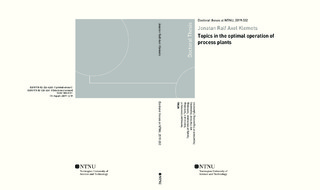| dc.description.abstract | An increasingly competitive global market, together with stricter environmental and safety regulations make it necessary for chemical process plants to operate close to its optimum. As a result, there has been a growing interest in online optimization methods, e.g., model predictive control (MPC), real-time optimization (RTO), and economic MPC (EMPC). However, implementing such techniques remains challenging, mainly due to the computational complexity and lack of accurate dynamic models. Another approach is to use simple control structures that keep specific controlled variables (CVs) at a constant value, also known as selfoptimizing control [122]. The central idea of self-optimizing control is to select CVs such that in the presence of disturbances, the loss is minimized by holding them at constant set-points. Besides using single measurements, selecting linear combinations of measurements as CVs will further improve the self-optimizing control performance.
Using all measurements available will, in theory, give the smallest loss, but increases the risk of getting sensor failures and makes implementing the control structure more di cult. Instead, it is preferable to nd an optimal measurement subset using the branch and bound method derived in [26] or the mixed-integer quadratic programming (MIQP) approach in [149]. However, when using decentralized control, it is often desirable to impose some structural constraints on the CVs. E.g., by only combining manipulated variables (MVs) with CVs associated with certain units or parts of the process. Unfortunately, when structural constraints are included, it makes the underlying optimization problem non-convex and thus, finding the optimal solution is di cult. In the rst part of this thesis, an alternating direction method of multipliers (ADMM) algorithm is proposed for incorporating structural constraints on the CVs. The resulting algorithm is computationally very efficient and able to find local solutions that give similar or better performance when compared to existing methods.
Self-optimizing control focuses on the steady-state operation, and therefore, the CVs are typically calculated using only steady-state models of the process. As a consequence, little attention has been put on the dynamic performance when selecting measurement combinations, where the general approach is to first compute the optimal CVs and then design their respective controllers. The optimal measurement combinations, can often (especially if many measurements are used) result in very dynamically complex systems, that makes designing the feedback controllers di cult. If dynamic models of the process are available, then it should be possible to also consider how using a measurement combination as CVs will affect the dynamics of the system. In the second part of the thesis, PI controllers and measurement combinations are simultaneously obtained with the aim to find an optimal trade-o between minimizing the steady-state loss and the transient response for the resulting closed-loop system. A solution can be found by solving a bilinear matrix inequality (BMI), which becomes a linear matrix inequality (LMI) by specifying a stabilizing state feedback gain. The resulting control structures were evaluated on several case studies that consisted of di erent distillation column models. The simulations showed that the resulting control structures could give comparable performance to model predictive controllers (MPC) as long the parameters for the PI controllers and the CVs had been chosen appropriately.
In the ideal case, it would be su cient to only use self-optimizing control variables with feedback controllers, since the operation would remain near-optimal without needing to change the set-points despite there being disturbances present. However, self-optimizing control alone is unlikely going to achieve truly optimal operation, and will probably require the inclusion of some online optimization method. Common for most of these algorithms (e.g., RTO, EMPC) is that they require more information about the current states and disturbances of the process. Measuring all the relevant states and disturbances is in general not possible, and thus, they must be estimated using appropriate state estimators. For chemical processes and other large-scale systems, using centralized state estimators are in general not favorable due to the high computational complexity. In addition, developing and maintaining a set of local models will, in general, be a lot easier compared to using a single global model. Therefore, it would be preferable to decompose them into multiple different local estimators, that uses a local model and the locally available measurements. From the different local estimates, it should be possible to reconstruct a more accurate global state vector using some appropriate fusion method. However, most existing fusion methods are limited to fusing only two state vectors of the same size, where each locally computed estimate refers to the same states. However, chemical processes are usually composed of di erent units where the dynamic model for each unit contain their own set of states, with some being shared between each other. Therefore, for the last part of this thesis, a fusion algorithm is proposed that is able to fuse multiple state estimates, where parts of the local state vectors are overlapping each other. The resulting algorithm was able to provide a fused estimate with a lower estimation error compared to existing fusion methods. | nb_NO |
